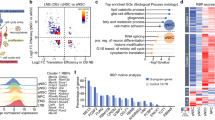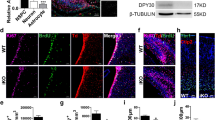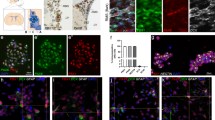Abstract
The subventricular zone (SVZ) is the largest neurogenic niche in the adult mammalian brain. We found that the brain-enriched microRNA miR-124 is an important regulator of the temporal progression of adult neurogenesis in mice. Knockdown of endogenous miR-124 maintained purified SVZ stem cells as dividing precursors, whereas ectopic expression led to precocious and increased neuron formation. Furthermore, blocking miR-124 function during regeneration led to hyperplasias, followed by a delayed burst of neurogenesis. We identified the SRY-box transcription factor Sox9 as being a physiological target of miR-124 at the transition from the transit amplifying cell to the neuroblast stage. Sox9 overexpression abolished neuronal differentiation, whereas Sox9 knockdown led to increased neuron formation. Thus miR-124–mediated repression of Sox9 is important for progression along the SVZ stem cell lineage to neurons.
This is a preview of subscription content, access via your institution
Access options
Subscribe to this journal
Receive 12 print issues and online access
$209.00 per year
only $17.42 per issue
Buy this article
- Purchase on Springer Link
- Instant access to full article PDF
Prices may be subject to local taxes which are calculated during checkout








Similar content being viewed by others
References
Doetsch, F., Caille, I., Lim, D.A., Garcia-Verdugo, J.M. & Alvarez-Buylla, A. Subventricular zone astrocytes are neural stem cells in the adult mammalian brain. Cell 97, 703–716 (1999).
Menn, B. et al. Origin of oligodendrocytes in the subventricular zone of the adult brain. J. Neurosci. 26, 7907–7918 (2006).
Lachapelle, F., Avellana-Adalid, V., Nait-Oumesmar, B. & Baron-Van Evercooren, A. Fibroblast growth factor-2 (FGF-2) and platelet-derived growth factor AB (PDGF AB) promote adult SVZ-derived oligodendrogenesis in vivo. Mol. Cell. Neurosci. 20, 390–403 (2002).
Bartel, D.P. MicroRNAs: genomics, biogenesis, mechanism and function. Cell 116, 281–297 (2004).
Stefani, G. & Slack, F.J. Small non-coding RNAs in animal development. Nat. Rev. Mol. Cell Biol. 9, 219–230 (2008).
Flynt, A.S. & Lai, E.C. Biological principles of microRNA-mediated regulation: shared themes amid diversity. Nat. Rev. Genet. 9, 831–842 (2008).
Lagos-Quintana, M. et al. Identification of tissue-specific microRNAs from mouse. Curr. Biol. 12, 735–739 (2002).
Lim, L.P. et al. Microarray analysis shows that some microRNAs downregulate large numbers of target mRNAs. Nature 433, 769–773 (2005).
Conaco, C., Otto, S., Han, J.J. & Mandel, G. Reciprocal actions of REST and a microRNA promote neuronal identity. Proc. Natl. Acad. Sci. USA 103, 2422–2427 (2006).
Krichevsky, A.M., Sonntag, K.C., Isacson, O. & Kosik, K.S. Specific microRNAs modulate embryonic stem cell-derived neurogenesis. Stem Cells 24, 857–864 (2006).
Makeyev, E.V., Zhang, J., Carrasco, M.A. & Maniatis, T. The microRNA miR-124 promotes neuronal differentiation by triggering brain-specific alternative pre-mRNA splicing. Mol. Cell 27, 435–448 (2007).
Visvanathan, J., Lee, S., Lee, B., Lee, J.W. & Lee, S.K. The microRNA miR-124 antagonizes the anti-neural REST/SCP1 pathway during embryonic CNS development. Genes Dev. 21, 744–749 (2007).
Cao, X., Pfaff, S.L. & Gage, F.H. A functional study of miR-124 in the developing neural tube. Genes Dev. 21, 531–536 (2007).
Noctor, S.C., Flint, A.C., Weissman, T.A., Dammerman, R.S. & Kriegstein, A.R. Neurons derived from radial glial cells establish radial units in neocortex. Nature 409, 714–720 (2001).
Haubensak, W., Attardo, A., Denk, W. & Huttner, W.B. Neurons arise in the basal neuroepithelium of the early mammalian telencephalon: a major site of neurogenesis. Proc. Natl. Acad. Sci. USA 101, 3196–3201 (2004).
Pastrana, E., Cheng, L.-C. & Doetsch, F. Simultaneous prospective purification of adult subventricular zone neural stem cells and their progeny. Proc. Natl. Acad. Sci. USA (in press).
Doetsch, F., Petreanu, L., Caille, I., Garcia-Verdugo, J.M. & Alvarez-Buylla, A. EGF converts transit-amplifying neurogenic precursors in the adult brain into multipotent stem cells. Neuron 36, 1021–1034 (2002).
Lim, D.A. & Alvarez-Buylla, A. Interaction between astrocytes and adult subventricular zone precursors stimulates neurogenesis. Proc. Natl. Acad. Sci. USA 96, 7526–7531 (1999).
Malatesta, P., Hartfuss, E. & Gotz, M. Isolation of radial glial cells by fluorescent-activated cell sorting reveals a neuronal lineage. Development 127, 5253–5263 (2000).
Meister, G., Landthaler, M., Dorsett, Y. & Tuschl, T. Sequence-specific inhibition of microRNA- and siRNA-induced RNA silencing. RNA 10, 544–550 (2004).
Hutvagner, G., Simard, M.J., Mello, C.C. & Zamore, P.D. Sequence-specific inhibition of small RNA function. PLoS Biol. 2, E98 (2004).
Davidson, T.J. et al. Highly efficient small interfering RNA delivery to primary mammalian neurons induces MicroRNA-like effects before mRNA degradation. J. Neurosci. 24, 10040–10046 (2004).
Sempere, L.F. et al. Expression profiling of mammalian microRNAs uncovers a subset of brain-expressed microRNAs with possible roles in murine and human neuronal differentiation. Genome Biol. 5, R13 (2004).
Doetsch, F., Garcia-Verdugo, J.M. & Alvarez-Buylla, A. Regeneration of a germinal layer in the adult mammalian brain. Proc. Natl. Acad. Sci. USA 96, 11619–11624 (1999).
Lewis, B.P., Shih, I.H., Jones-Rhoades, M.W., Bartel, D.P. & Burge, C.B. Prediction of mammalian microRNA targets. Cell 115, 787–798 (2003).
Zhao, Y., Samal, E. & Srivastava, D. Serum response factor regulates a muscle-specific microRNA that targets Hand2 during cardiogenesis. Nature 436, 214–220 (2005).
Chen, C.Z., Li, L., Lodish, H.F. & Bartel, D.P. MicroRNAs modulate hematopoietic lineage differentiation. Science 303, 83–86 (2004).
Smirnova, L. et al. Regulation of miRNA expression during neural cell specification. Eur. J. Neurosci. 21, 1469–1477 (2005).
Panganiban, G. & Rubenstein, J.L. Developmental functions of the Distal-less/Dlx homeobox genes. Development 129, 4371–4386 (2002).
Nyfeler, Y. et al. Jagged1 signals in the postnatal subventricular zone are required for neural stem cell self-renewal. EMBO J. 24, 3504–3515 (2005).
Finzsch, M., Stolt, C.C., Lommes, P. & Wegner, M. Sox9 and Sox10 influence survival and migration of oligodendrocyte precursors in the spinal cord by regulating PDGF receptor α expression. Development 135, 637–646 (2008).
Stolt, C.C. et al. The Sox9 transcription factor determines glial fate choice in the developing spinal cord. Genes Dev. 17, 1677–1689 (2003).
Nowak, J.A., Polak, L., Pasolli, H.A. & Fuchs, E. Hair follicle stem cells are specified and function in early skin morphogenesis. Cell Stem Cell. 3, 33–43 (2008).
Bastide, P. et al. Sox9 regulates cell proliferation and is required for Paneth cell differentiation in the intestinal epithelium. J. Cell Biol. 178, 635–648 (2007).
Vidal, V.P. et al. Sox9 is essential for outer root sheath differentiation and the formation of the hair stem cell compartment. Curr. Biol. 15, 1340–1351 (2005).
Krichevsky, A.M., King, K.S., Donahue, C.P., Khrapko, K. & Kosik, K.S. A microRNA array reveals extensive regulation of microRNAs during brain development. RNA 9, 1274–1281 (2003).
Bartel, D.P. & Chen, C.Z. Micromanagers of gene expression: the potentially widespread influence of metazoan microRNAs. Nat. Rev. Genet. 5, 396–400 (2004).
Ballas, N., Grunseich, C., Lu, D.D., Speh, J.C. & Mandel, G. REST and its corepressors mediate plasticity of neuronal gene chromatin throughout neurogenesis. Cell 121, 645–657 (2005).
Singh, S.K., Kagalwala, M.N., Parker-Thornburg, J., Adams, H. & Majumder, S. REST maintains self-renewal and pluripotency of embryonic stem cells. Nature 453, 223–227 (2008).
Choi, P.S. et al. Members of the miRNA-200 family regulate olfactory neurogenesis. Neuron 57, 41–55 (2008).
Silber, J. et al. miR-124 and miR-137 inhibit proliferation of glioblastoma multiforme cells and induce differentiation of brain tumor stem cells. BMC Med. 6, 14 (2008).
Lim, D.A. et al. Noggin antagonizes BMP signaling to create a niche for adult neurogenesis. Neuron 28, 713–726 (2000).
Acknowledgements
We thank K. Gordon for assistance with FACS at the Herbert Irving Comprehensive Cancer Center at Columbia University. We thank members of the Doetsch and Wichterle laboratories for critical reading of the manuscript. We are grateful to C. Troy for advice on penetratin 1–mediated delivery, N. Heintz for antibody to BLBP and R. Tsien for pCMV-Cherry plasmid. The nestin, M2 and M6 antibodies developed by S. Hockfield and C. Lagenaur, respectively, were obtained from the Developmental Studies Hybridoma Bank developed under the auspices of the National Institute of Child Health and Human Development and maintained by the University of Iowa. This work was supported by a US National Institutes of Health National Institute of Neurological Disorders and Stroke grant to F.D. E.P. was supported by a US National Institutes of Health training grant and a grant from the Spanish Ministerio de Educacion y Ciencia. M.T. was supported by a Medical Scientist Training Program fellowship from the US National Institutes of Health, F.D. is a Packard Foundation Fellow and an Irma T. Hirschl Fellow, and this work was partially supported by the Jerry and Emily Spiegel Laboratory for Cell Replacement Therapies and the Anne and Bernard Spitzer Fund for Cell Replacement Therapy. We dedicate this article to the memory of Emily Spiegel.
Author information
Authors and Affiliations
Contributions
L.-C.C. and F.D. initiated the project. L.-C.C. generated the pSUPERretro (pSR)-GFP, pSR-124mt and pSR-shRNA constructs. L.-C.C. and M.T. generated the pSR-124 construct. M.T. and E.P. generated the Sox9 overexpression construct. L.-C.C. performed the in situ hybridization, qRT-PCR, neurosphere assays, neuron survival assays, Sox9 expression assay, retroviral production, penetratin conjugation, in vivo delivery and Ara-C experiments. L.-C.C. and E.P. carried out the FACS sorting, cocultures, adherent cultures and in vivo injections. E.P. performed the Gene Ontology studies. M.T. carried out the luciferase assays and Sox9 immunohistochemistry. F.D. was involved in the study design, data collection, quantification and data analysis. The manuscript was written by F.D., L.-C.C. and E.P. All authors performed data quantification, discussed the results and commented on the manuscript.
Corresponding author
Supplementary information
Supplementary Text and Figures
Supplementary Figures 1–8, Supplementary Tables 1 and 2, and Supplementary Methods (PDF 2797 kb)
Rights and permissions
About this article
Cite this article
Cheng, LC., Pastrana, E., Tavazoie, M. et al. miR-124 regulates adult neurogenesis in the subventricular zone stem cell niche. Nat Neurosci 12, 399–408 (2009). https://doi.org/10.1038/nn.2294
Received:
Accepted:
Published:
Issue Date:
DOI: https://doi.org/10.1038/nn.2294
This article is cited by
-
MicroRNA Profiling of Self-Renewing Human Neural Stem Cells Reveals Novel Sets of Differentially Expressed microRNAs During Neural Differentiation In Vitro
Stem Cell Reviews and Reports (2023)
-
Molecular Mechanisms Involved in the Regulation of Neurodevelopment by miR-124
Molecular Neurobiology (2023)
-
SOX9 in organogenesis: shared and unique transcriptional functions
Cellular and Molecular Life Sciences (2022)
-
The roles of microRNAs in mouse development
Nature Reviews Genetics (2021)
-
MicroRNA-dependent control of neuroplasticity in affective disorders
Translational Psychiatry (2021)



